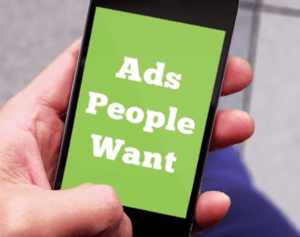Have you ever started thinking of buying something such as a new computer? So, you start doing a little research, maybe you watch a video online and read some blogs. Then, suddenly, you start seeing ads online related to computers. If this sounds familiar, you may have wondered how advertisers know when and what ads to serve you.
This level of ad personalization keeps content relevant to best serve the consumer. Ad companies have the ability to capture information such as relevant searches to share new and exciting products. While this may seem weird to some, studies have shown that more consumers actually prefer personalized advertisements. With the right mixture of relevance and timeliness, your ads can make a great impression on consumers.
Have you wondered how advertisers get information about consumers? Organizations collect information on search queries, online activity, demographic information, and location. With website analytics, businesses can remarket to consumers who have made past purchases, completed certain actions, and even just visited their site.
The best ways to personalize advertising are through interest-based advertising, location, and contextual advertising.
Here are 4 ways to increase ad personalization

Interest-based advertising
Interested-based advertising targets a user based on websites and even apps that they’ve visited in the past. Advertisers can select specific interests and provide a better, more relevant experience for consumers. For example, if an individual frequents sites for women’s clothing, and you have an online fashion boutique targeting women, then this is a consumer whom you would want to show your ads.
Geo-targeting
Geotargeting allows advertisers to target consumers based on location. For example, if geo data shows that a consumer is within a specific area that your business is based, your ad could show to them. Here’s an example, let’s say the consumer is in the neighborhood and searches for a restaurant. An ad for your restaurant could show to that consumer with a 10 percent off digital coupon.
Contextual advertising
This allows advertisers to show ads based on context. For example, if your business sells car parts, and an individual is searching blogs on how to do an oil change or the best chains for the winter season, then your ads reflecting your relevant products would show to the consumer.
Retargeting
You can retarget consumers who have visited your website with the proper tracking in place. Consumers are more likely to purchase new products from a business that they are familiar with, according to BusinessWire. Let’s say a customer has purchased from your online business in the past, you can target them while they are browsing the internet with the new product they may be interested in. Retargeting is a great way to re-engage with your customer base.
Ad personalization is the key to relevant, click-worthy advertisements that consumers will respond to. Personalized ads can produce higher click-through rates and a lower acquisition cost. When personalized ads are delivered the right way, businesses can also see a positive return on investment. To leverage personalization, it is important to collect the right data and know how to use it for your business to reach customers through location, interests, context, and retargeting.
To ensure you have the right targeting and messaging in place, you will want to enlist seasoned professionals to deploy your strategy. To see how personalization can help your business’s ad strategy, contact Thumbvista.

